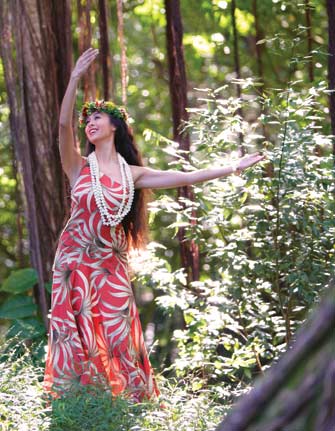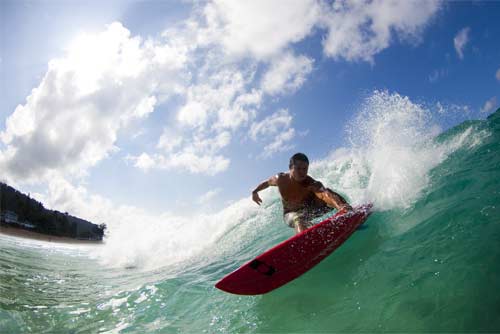PERSPECTIVES
HULA
There is perhaps nothing more conceptually elusive than the future.

Who: Sarah Kamalei Noyle Hawaiian Name: Kamalei I ka Poli, A professional hula dancer, 21 years old. Born and raised in Hawaii. Ethnic background: English/Chinese
Where (Halau): Halau I Ka Wekiu- Kumu: Michael Casupang and Karl Veto Baker Hula Lineage from Aunt Maiki Aiu Lake who was kumu to Robert Cazimero,who, in turn, is Kumu to Casupang and Baker.
When: Started Hula at 7 years old
Currently: A solo hula dancer weekly at the Moana Surfrider at Sunset. Also a dancer with Tihati Productions at the Hilton and Royal Hawaiian Hotel. She also has her own hula line called “Kamalei”, a contemporary and classic- sophisticated and sassy hula line reflecting an elegant, beautiful Hawaii. ~Kamalei~ was originally created for the contemporary and sophisticated hula dancer, Sarah Kamalei Noyle. As inspiration, consultant and spokes- model, Sarah has danced wearing ~Kamalei~ in Honolulu, Tokyo, and Sapporo. She has chosen colors, fabrics and designs to reflect the beauty of the dances, the movement of the dancer and the sole of the music. Each piece has been created to enhance the story told by the hula.
__________________________________________________
-2-
Q&A with Rico Jimenez:

Who is Rico Jimenez besides the surfer? A Local boy who loves his Fish and Poi.
Classic or Modern Cars/Trucks? All Modern! I love Anything Loud and Fast! Big trucks and street bikes!
Your favorite hole in the wall restaurant? I love Pupukea Grill! It’s a little plate lunch truck by my house that has the meanest grinds! Garins for broke your hip!
Hawaiian Sun or Aloha Maid? Hawaiian Sun, Guava nectar!
Finish the following: Shaved Ice is... Mean when with a honey girl on a hot day
Most unreal surf spot you have been to (Not Hawaii): Teahupoo, Tahiti is mean!!
How are you innov8ative? I don’t know if I’m Innov8ative....but I do what I like and don’t really care if everyone is into it or not, as long as it makes me happy.. I guess the key is to never stop learning.
__________________________________________________
-3-
Future Thought
Words: John A. Sweeney
There is perhaps nothing more conceptually elusive than the future.
What do you really know about the future? What do you think you know about the future? More to the point, how do you know to think about the future? What!?! There is perhaps nothing more conceptually elusive than the future- that which has yet to come, that which remains shrouded in mystery, that which depends on the past and can never be found in the present...THE FUTURE! Thankfully, professional futurists (yes, there is such a thing) ponder these questions, and they offer some handy guidelines for thinking about the future, which is not as easy as you might think!
It just so happens that the Political Science Department at the University of Hawai'i at Mānoa is home to one of the world's foremost futurists—Dr. Jim Dator. As Director of the Hawaii Research Center for Futures Studies, head of the Mānoa School of Futures Studies, and the patriarch of college-level Futures Studies, Dr. Dator offers seven directives—conspicuously known as Dator's “Laws” of the Future—for understanding and engaging in the practice of futures studies.
1) “The future” cannot be “studied” because “the future” does not exist! The notion that the future is determinable and singular does not jive with futurists. There are, in fact, futures and one can study images of the future—think alternate universes—which represent potential visions of the future.
2) “The future” cannot be “predicted,” but “alternative futures” can, and should be “forecast.” Futurists plot scenarios as to what the future can and might be for an organization, a nation, the world, etc. Similarly, individuals can and ought to work towards building one's own alternative or preferred future—a specialty of the Mānoa School of Futures Studies.
3) There is no such thing as a “best case scenario” or a “worst case scenario.” All futures present obstacles and opportunities, and it is the task of the futurist to identify and interpret the possibilities and potentialities of the futures under consideration.
4) What is often popularly, or even professionally, considered to be “the most likely future” is, in all probability, one of the least likely futures. A look at the past should tell one that the future is not easily identifiable—thus, one should, in the words of the Greek philosopher Heraclitus, “expect the unexpected” concerning the future.
5) “The future” cannot be “predicted,” but “preferred futures” can and should be envisioned, invented, implemented, continuously evaluated, revised, and re-envisioned. Like the streets of Honolulu, futures remain under permanent construction and should be revisited consistently for upgrades and expansions.
6) Any useful idea about the future should appear to be ridiculous. Airplanes? The Internet? All were at one time completely outlandish and unimaginable concepts, yet we cannot imagine a world—certainly a present...perhaps even a future—without them.
7) If futurists expect to be useful, they should expect to be ridiculed and for their ideas initially to be rejected. Considering the above, this requires no explanation.
A good futurist is not afraid to ask the same question twice: how do you know to think about the future(s) now? Futures Studies requires intellectual discipline and rigor tempered with an ability to laugh at one's self—as Dator's seven directives suggest, there are many absurd things that come out of the mouths of futurists, but occasionally they have been heard to mutter, “I told you so!”


Click to Book go Mokulele Flight
742ac1e7-d5d1-4884-9b85-a9f445b51b7f|2|3.0